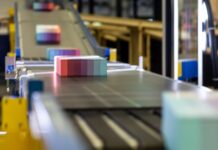With the increasing digitalization of the packaging industry, there are undeniable benefits, but it also brings a significant challenge – the rise of counterfeiting.
Counterfeit products not only harm operations and brand reputation but can also pose real dangers to consumers, particularly in the case of counterfeit automobile parts and medicines, which can be fatal for unsuspecting individuals. To address this issue, smart packaging can be implemented in supply chains to help brands minimize losses caused by counterfeiting.
How can companies stop counterfeit products in the digital marketplace through packaging?
Authentication methods have evolved from passive approaches to address the complexity of online marketplaces and improve the detection of counterfeit packaging. A layered approach involving primary, secondary, and tertiary packaging can protect products. Primary packaging secures the product with techniques like artwork, labels, or holograms. Secondary packaging tracks units through QR codes or RFID. Tertiary packaging employs AI technologies, such as invisible signatures, to assess authenticity. Investing in infrastructure that connects digital and physical products allows proactive detection of counterfeits, eliminating reliance on chance encounters. Companies must embrace these measures in the digital age to safeguard their products.
What more is there to learn about invisible signatures?
Invisible signatures are cryptographic markers integrated into product packaging. Customers can scan the packaging with a mobile app to determine authenticity. Invisible signatures are cost-effective and offer consumer engagement opportunities. Brands can address instances of encountering fake products, fostering trust with customers. Unlike traditional technologies, invisible signatures require less capital expenditure and equipment.
How does smart packaging provide analytics for counterfeit products?
Smart packaging enables brands to identify regions with higher rates of counterfeit products and trace their movement. It can incorporate track and trace capabilities, demarcated regions for specific markets, and signatures indicating intended market suitability. These analytics help brands isolate counterfeit sources and make informed decisions about their business strategy.
Which industries are affected the most by counterfeiting?
Counterfeiting is a significant challenge for industries, particularly larger companies with strong brand reputations. The pharmaceutical industry is heavily affected, with up to 50% of medical products in African nations being falsified. Applying additional materials to packaging in this industry requires regulatory approval. The automotive industry also suffers from counterfeiting, risking fatal accidents due to aftermarket counterfeit parts. It’s crucial for all companies to prioritize countermeasures early on, as recalling and recertifying products becomes difficult once they are in circulation. Tailored solutions for each industry, including the use of smart packaging, can effectively combat counterfeiting.
How does smart packaging aid consumer engagement?
Smart packaging enhances consumer engagement through personalization and gamification. Personalized packaging creates a stronger connection between consumers and brands, increasing the likelihood of repeat purchases. Gamification, such as providing interactive content or incentives upon scanning smart packaging, boosts engagement and surpasses traditional leaflets. These approaches create a more memorable and interactive experience for consumers.
What are the limits of smart packaging?
Limitations of smart packaging include dependency on internet connectivity, particularly in areas with limited access. Market maturity and consumer education also present challenges. Protecting cybersecurity and consumer privacy while leveraging data through packaging is a complex task that requires attention. However, ongoing technological advancements and increased adoption are gradually addressing these limitations.




























